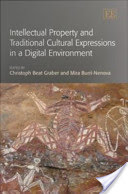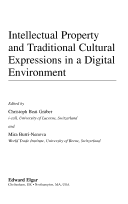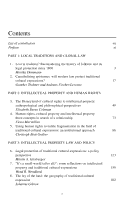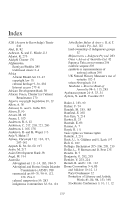Intellectual Property and Traditional Cultural Expressions in a Digital Environment (Google eBook)This book is a very significant contribution to the question of protecting traditional cultural expressions. . . It is filled with fascinating ideas and perspectives that challenge the reader to rethink the law once again. Jamil Ammar, European Intellectual Property Review Legal protection for traditional cultural expressions is an area of contemporary policy making characterized by widespread concern and considerable controversy. Intellectual property scholars have a dire need for informed perspectives on the history of this subject area and the lucid commentary on its social and political implications that the authors of these cogent interdisciplinary essays provide. This impressive volume promises to be quickly acknowledged as an indispensable guide to the issues in this field. Rosemary J. Coombe, York University, Canada The first wave of scholarship on cultural appropriation was often better at denunciation than at grappling with the complexities of cultural heritage and its protection. Intellectual Property and Traditional Cultural Expressions in a Digital Environment launches a second wave: nuanced, interdisciplinary, looking past accusation toward flexible solutions. For all that, it is no less committed to social justice. By bringing together leading-edge scholarship from law, the arts, communications, anthropology, history, and philosophy, the editors have taken research on heritage protection to the next level of sophistication. Michael F. Brown, Williams College, US and author of Who Owns Native Culture? In the face of increasing globalisation, and a collision between global communication systems and local traditions, this book offers innovative trans-disciplinary analyses of the value of traditional cultural expressions (TCE) and suggests appropriate protection mechanisms for them. It combines approaches from history, philosophy, anthropology, sociology and law, and charts previously untravelled paths for developing new policy tools and legal designs that go beyond conventional copyright models. Its authors extend their reflections to a consideration of the specific features of the digital environment, which, despite enhancing the risks of misappropriation of traditional knowledge and creativity, may equally offer new opportunities for revitalising indigenous peoples values and provide for the sustainability of TCE. This book will appeal to scholars interested in multidisciplinary analyses of the fragmentation of international law in the field of intellectual property and traditional cultural expressions. It will also be valuable reading for those working on broader governance and human rights issues. |
What people are saying - Write a review
We haven't found any reviews in the usual places.
Contents
| 3 | |
| 17 | |
| 49 | |
| 73 | |
| 96 | |
| 123 | |
| 150 | |
| 182 | |
| 205 | |
| 237 | |
Commercializing cultural heritage? Criteria for a balanced instrumentalization of traditional cultural expressions for development in a globalized digit... | 256 |
| 287 | |
| 303 | |
| 315 | |
Common terms and phrases
Aboriginal Annex Article artistic Australia Ayahuasca benefit Biopiracy CCPR CESCR Christoph Beat Graber claims concept Coombe copyright law creativity cultural diversity cultural identity cultural property cultural rights customary law digital environment discussion Diversity of Cultural economic development Edward Elgar entered into force expressions of folklore expressions/expressions of folklore forms framework Genetic Resources global groups human rights Ibid indigenous indigenous communities individual information and communication innovation Intangible Cultural Heritage Intellectual Property Law intellectual property rights International Law Internet IP rights issues Knowledge and Folklore Kymlicka land Law Review Michael Blakeney misappropriation modern norms parties patent political production Protection and Promotion protection of TCE Protection of Traditional public domain regard relationship relevant Safeguarding society supra note technologies tion tional Trade traditional cultural expressions traditional cultural expressions/expressions traditional knowledge UNESCO Convention United Nations University Press WIPO’s World Bank World Trade Organization






